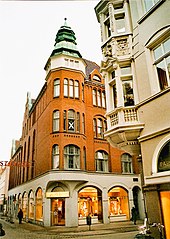Bernhard von Hindenburg
Bernhard August Richard von Beneckendorff and von Hindenburg , pseudonym : Bernhard von Burgdorff (born January 17, 1859 in Glogau , Silesia ; † February 23, 1932 in Lübeck ) was a Prussian officer and writer.
Life
origin
Bernhard came from the noble family of Beneckendorff and von Hindenburg . He was the youngest son of the manor owner and major a. D. Robert von Beneckendorff and von Hindenburg (* May 21, 1816 in Gut Neudeck ; † April 16, 1902 there) and his wife Luise Schwickart (* April 21, 1825 in Posen ; † August 5, 1893). His older brother Paul (1847–1934) also embarked on a military career, made it up to General Field Marshal and was Reich President from 1925 .
Military career
Coming from the cadet corps, Hindenburg was transferred on April 15, 1878 as portepee - ensign to the 1st Hanoverian Dragoons Regiment No. 9 of the Prussian Army in Metz . Promoted to second lieutenant on January 13, 1880 , he was given a year-long vacation on January 13, 1883 under position à la suite of his regiment from February 1 . He was re-enlisted on November 15, 1883 in the Minden infantry regiment "Prince Friedrich of the Netherlands" (2nd Westphalian) No. 15 . His resignation was granted on July 14, 1885 .
On December 14, 1886, Hindenburg rejoined the army and was employed in the 2nd Hanseatic Infantry Regiment stationed in the Free Hanseatic Cities of Hamburg and Lübeck . From June 4 to July 16, 1888 he was the Schleswig-Holstein Pioneer Battalion No. 9 in Harburg of the IX. Army Corps and from May 9 to September 16, 1889, assigned to the Infantry Training Battalion . On March 24, 1890, Hindenburg was promoted to Prime Lieutenant , with a patent from December 15, 1889, transferred to the Grenadier Regiment "King Friedrich Wilhelm I." (2nd East Prussian) No. 3 in Königsberg . His resignation with board and permission to wear the army uniform was him on 17 November 1892 approved .
After leaving, he settled in Dresden . During the First World War , Hindenburg wrote the first biography about his older brother, the " hero of Tannenberg ", who a short time later was to take over the Supreme Army Command together with Erich Ludendorff . Later he mainly wrote short novels and plays .
After his wife's death in 1927, he moved to her hometown and lived with a sister-in-law who was also widowed. The von Hindenburgs were buried in the Burgtorfriedhof .
family

Hindenburg married Emilie Charlotte Adele Fehling (born April 1, 1865 in Lübeck, † November 16, 1927 in Dresden) in the Marienkirche in Lübeck in 1890 . She was the daughter of the Lübeck businessman and senator Johannes Fehling . The marriage remained childless.
Works
- Paul von Hindenburg. A picture of life . Schuster & Loeffler, Berlin 1915. ( digitized version ). New edition: Field Marshal von Hindenburg. A picture of life. August Scherl, Berlin 1916. ( digitized version ).
- The Amber King. Novel. 1915.
- Maria. Acting in 4 acts. Acting in 4 acts. 1922.
- Bells ringing. Drama and dream play in 1 act. 1923.
- Maria. Acting in 4 acts. 1923.
- Thought fragments, poems, fairy tales. 1923.
- The legend stones. Tragedy in 3 acts. 1923.
- The ring. Acting in 4 acts. 1925.
- Slag. Acting in 3 acts. 1925.
- Galileo. Tragedy in 5 acts. 1925.
- The future. Comedy and dream play in 3 acts. 1925.
- The poet. Stagger in 4 lifts. 1925.
- The blue flower. Drama in 5 acts. 1925.
- Dust. A stage dream in 5 acts. 1925.
literature
- Gerhard Ahrens : Hindenburg's brother lies in the Burgtorfriedhof. In: Lübeckische Blätter . 2010, pp. 390-391.
- Harry von Rège : Officer master list of the infantry regiment No. 76. Mauke, Hamburg 1902. OCLC 252978009 . Pp. 127-128
- Alfred Cramer : Officer list of the infantry regiment "Prince Friedrich of the Netherlands" (2nd Westphalian) No. 15. Eisenschmidt 1913. p. 339.
Web links
- Literature by and about Bernhard von Hindenburg in the catalog of the German National Library
Individual evidence
- ↑ Life data according to Wilhelm Kosch, Bruno Berger, Heinz Rupp, Carl Ludwig Lang: German Literature Lexicon. Haab-Hogrebe. 1994, p. 366.
| personal data | |
|---|---|
| SURNAME | Hindenburg, Bernhard von |
| ALTERNATIVE NAMES | Beneckendorff and von Hindenburg, Bernhard von (full name); Burgdorff, Bernhard von (pseudonym) |
| BRIEF DESCRIPTION | Prussian officer and writer |
| DATE OF BIRTH | January 17, 1859 |
| PLACE OF BIRTH | Glogau |
| DATE OF DEATH | February 23, 1932 |
| Place of death | Lübeck |


